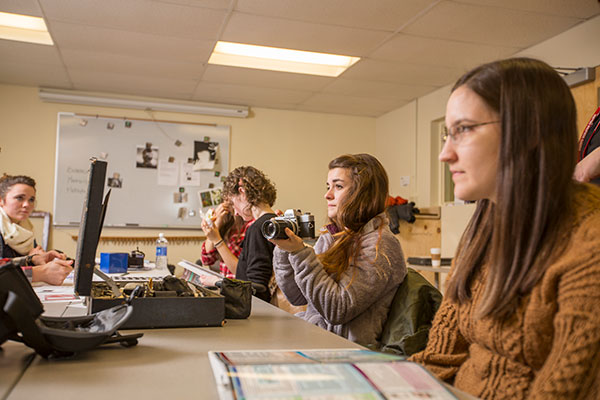Graphic Design
Learn to be a visual problem solver.
The Graphic Design concentration teaches you to become a visual problem solver who makes valuable contributions to our world. You will learn to translate ideas, information and data into communications through the use of typography, space, illustrations, photography, charts, words and color. Graphic design is everywhere.
Connect With Us
Do you have questions you need answered about the program and the admissions process? Visit Campus to connect with an Undergraduate Admissions Counselor!
Get More Info
4 Year Promise
At Roberts, we are committed to giving you a head start in earning income and achieving your personal goals by helping you graduate in four years. In fact, we guarantee it.
Program Highlights
PREPARE FOR YOUR CAREER
Choose from a wide variety of internships and studio apprenticeships in the Rochester area to gain experience.
RELATIONAL BASED TEACHING
Class sizes of 12 or less and professors dedicated to mentoring their students.
STATE OF THE ART FACILITIES
Hone your digital media art skills using our advanced media labs.
Greater Stories

Romy Hosford, M.F.A., is a multimedia artist and educator and has taught at Roberts since 2011. Her photo/video-based installation work can be described as storytelling through an object, material, and historical context, often dealing with perception, definition, and expectation. In addition, it investigates the concept of memory - personal and cultural, remembering and forgetting.
Romy Hosford, M.F.A.
What Will I Learn
If you are interested in working in the field of graphic design, this concentration will teach you mastery of design principles, theories, and technical skills, all within a broader studio art framework.
You will be exposed to all aspects of graphic design, including:
- Publication
- Advertising
- Corporate identity and branding
- Packaging
- Interactive & web design
- Environmental signage
- Motion graphics
You will learn by developing solutions for complex communication challenges based on real-world parameters such as budget, time, space, technology, and production methods.

Career Outlook
Student Teaching Placements
You will complete an internship in graphic design, as well as the following courses:
- Typography
- Introduction to Graphic Design
- Design for Print & Products
- Publication & Information Design
- Time Motion Communications
- Intro to Digital Imaging
- Intermediate Digital Photography
- Web Design
Frequently Asked Questions
As a graphic designer, you'll use images, graphics and text to communicate a variety of messages. This profession is extremely versatile; you could design media for advertising, entertainment, or news publications – both in print and online.
In addition to creativity, style, originality, excellent communication skills, and experience using computer graphics, animation, and design software, planning your continued education requires careful preparation, including putting together a visual portfolio of graphic design skills you've honed. For most entry-level and advanced graphic design positions, you will need a minimum of a bachelor’s degree from an accredited university, college, or private design school.
There are a number of factors that may impact the salary of a graphic designer–these may include years of experience, education level, design knowledge and software expertise, location and type of employer. As reported by Payscale, the average wage for this profession is $47,284.
Graphic design is an in-demand career option, and a bachelor's degree can give you the edge. With a degree, you'll be more qualified for positions and could potentially get higher initial salaries. College can provide you the foundational skills and experience needed to pursue a career in graphic design, while also enabling you to network with professionals and establish your portfolio.
For those interested in a career in graphic design, a minimum of a bachelor's degree from an accredited college or university is required. Alternatively, those seeking an associate's degree will find programs offered at numerous schools across the country. Upon graduation, you can pursue assistant-level positions in the field with this 2-year degree. Someone who has already earned a bachelor's degree in another area may looking into completing either a two or three year program to learn technical requirements and receive certification for graphic design.